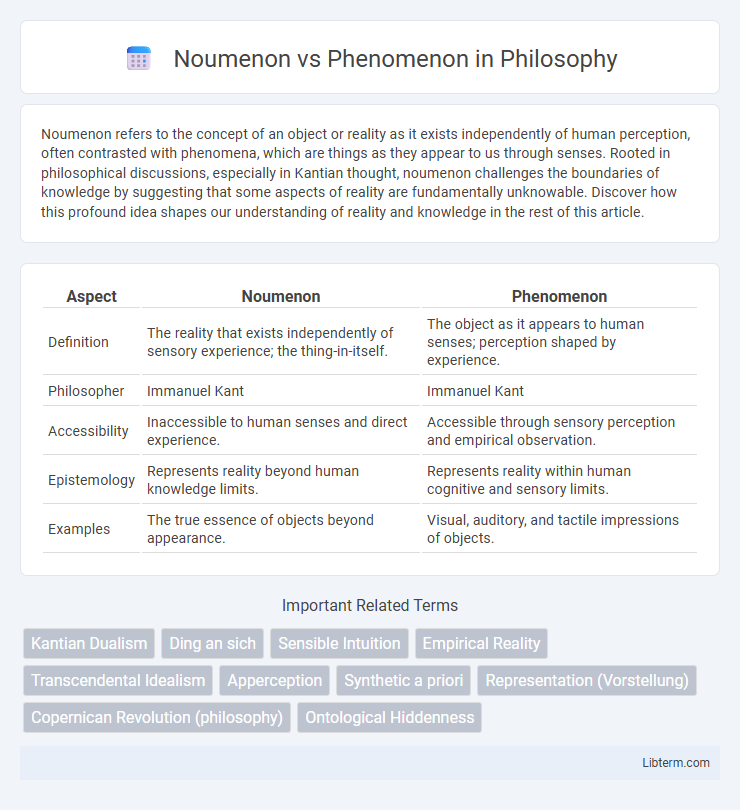Noumenon refers to the concept of an object or reality as it exists independently of human perception, often contrasted with phenomena, which are things as they appear to us through senses. Rooted in philosophical discussions, especially in Kantian thought, noumenon challenges the boundaries of knowledge by suggesting that some aspects of reality are fundamentally unknowable. Discover how this profound idea shapes our understanding of reality and knowledge in the rest of this article.
Table of Comparison
| Aspect | Noumenon | Phenomenon |
|---|---|---|
| Definition | The reality that exists independently of sensory experience; the thing-in-itself. | The object as it appears to human senses; perception shaped by experience. |
| Philosopher | Immanuel Kant | Immanuel Kant |
| Accessibility | Inaccessible to human senses and direct experience. | Accessible through sensory perception and empirical observation. |
| Epistemology | Represents reality beyond human knowledge limits. | Represents reality within human cognitive and sensory limits. |
| Examples | The true essence of objects beyond appearance. | Visual, auditory, and tactile impressions of objects. |
Introduction to Noumenon and Phenomenon
Noumenon refers to the thing-in-itself, an object or reality as it exists independently of human perception, central to Kantian philosophy. Phenomenon denotes the appearance or experience of an object as perceived through the senses, highlighting the distinction between reality and interpretation. Understanding noumenon and phenomenon is crucial for exploring the limits of human knowledge and the nature of subjective experience.
Historical Origins of the Concepts
The concepts of noumenon and phenomenon trace back to ancient philosophy, particularly within the works of Plato and Aristotle, where the distinction between the knowable sensory world and the intelligible realm began to emerge. Immanuel Kant critically developed these ideas in the 18th century, defining phenomena as the objects of experience and noumena as things-in-themselves, inaccessible to human perception. This Kantian framework fundamentally shaped subsequent metaphysical and epistemological debates on reality and perception.
Kant’s Philosophy: Defining Noumenon and Phenomenon
Kant's philosophy distinguishes noumenon as the reality that exists independently of human perception, inaccessible to sensory experience and pure reason alike, while phenomenon refers to the appearance of objects as they are perceived through the faculties of human senses and understood by the mind. Noumenon represents the "thing-in-itself" (Ding an sich), which cannot be directly known, whereas phenomenon encompasses the empirical data structured by space and time within human cognition. This fundamental dualism underscores Kant's critical project, emphasizing the limits of human knowledge and the conditions that shape experience.
Key Differences Between Noumenon and Phenomenon
Noumenon refers to the thing-in-itself, an object as it exists independently of perception, while phenomenon represents the object as it appears to the senses or mind. Noumenon is beyond human experience and cannot be directly known, whereas phenomena are accessible and observable through sensory experience. The key difference lies in noumenon being the intrinsic reality, contrasted with phenomenon as the interpreted or perceived reality.
Role of Human Perception in Reality
Noumenon represents the reality existing independently of human perception, while phenomenon refers to the reality as it appears through sensory experience. Human perception acts as a filter shaping phenomena by interpreting sensory inputs, thereby influencing the construction of perceived reality. Kantian philosophy emphasizes that understanding the noumenal world is inherently limited by the cognitive structures governing human perception.
Examples of Noumenal and Phenomenal Realms
The noumenal realm represents things as they are in themselves, beyond sensory experience, such as the concept of Kant's "thing-in-itself" or the underlying essence of a black hole imperceptible to direct observation. The phenomenal realm consists of appearances or objects as perceived by the senses, including observable phenomena like the colors and shapes of a sunset or the sound of a musical note. Distinguishing these realms highlights the contrast between objective reality (noumenon) and subjective experience (phenomenon) in epistemology and metaphysics.
Noumenon vs Phenomenon in Modern Philosophy
Noumenon and phenomenon represent distinct concepts in modern philosophy, where noumenon refers to the reality that exists independently of human perception, while phenomenon denotes the appearance of things as experienced through the senses. Immanuel Kant's critical philosophy emphasizes the noumenon as the "thing-in-itself," which remains unknowable, contrasting with the phenomenon as the accessible representation structured by human cognition. Contemporary debates explore how noumenal reality challenges empirical science's focus on phenomena, raising questions about the limits of human knowledge and the nature of objective existence.
Implications for Science and Knowledge
Noumenon represents the reality independent of perception, while phenomenon refers to the observable events experienced by the senses; this distinction challenges the limits of scientific inquiry by emphasizing that empirical data captures only appearances, not the underlying essence. Scientific methodologies rely heavily on phenomena, which restricts knowledge to what can be measured or observed, leaving noumenal truths potentially inaccessible. Philosophers like Kant argue that understanding these implications is crucial for recognizing the scope and boundaries of human cognition and scientific knowledge.
Critiques and Debates Surrounding the Concepts
Philosophical critiques of noumenon and phenomenon often challenge the accessibility of noumenal reality, arguing it remains inherently unknowable and thus limits meaningful discourse. Debates emphasize the epistemological divide between sensory experience (phenomena) and the supposed true essence beyond perception (noumena), questioning whether humans can ever bridge this gap. Some critics argue Kant's distinction creates an impractical dichotomy that complicates rather than clarifies the understanding of reality.
Conclusion: Understanding Reality Through Noumenon and Phenomenon
Noumenon represents the reality as it is in itself, independent of human perception, while phenomenon refers to the reality as it appears to our senses and cognition. Grasping the distinction between noumenon and phenomenon is crucial for deeper philosophical inquiry, emphasizing that human knowledge is limited to phenomena, whereas noumena remain inherently inaccessible. This dual framework enables a more nuanced understanding of reality, bridging the gap between subjective experience and objective existence.
Noumenon Infographic

 libterm.com
libterm.com